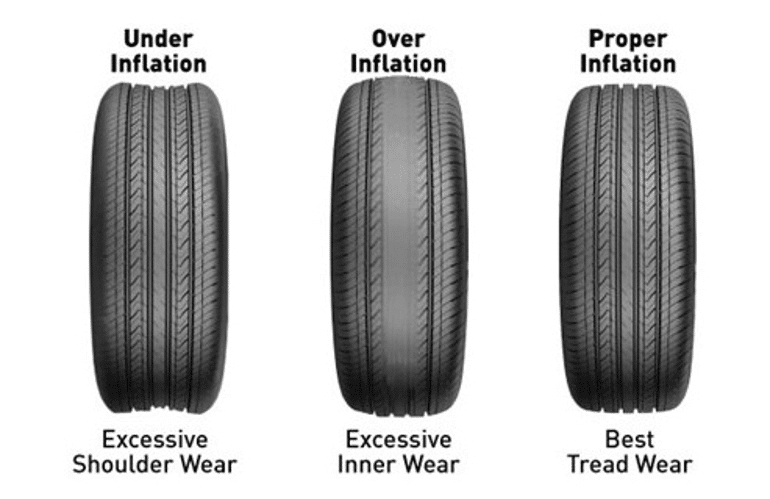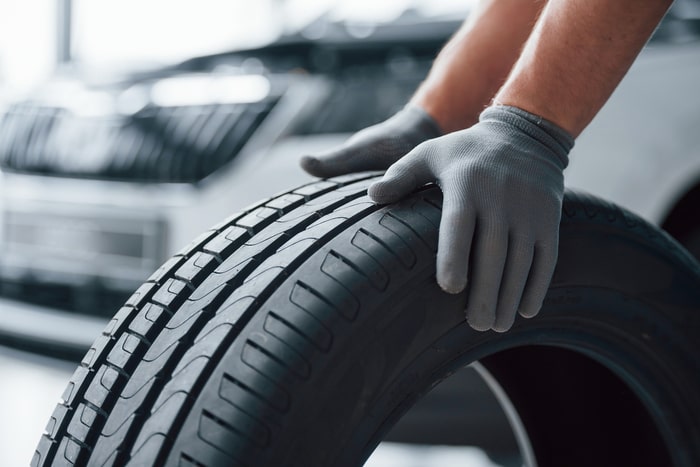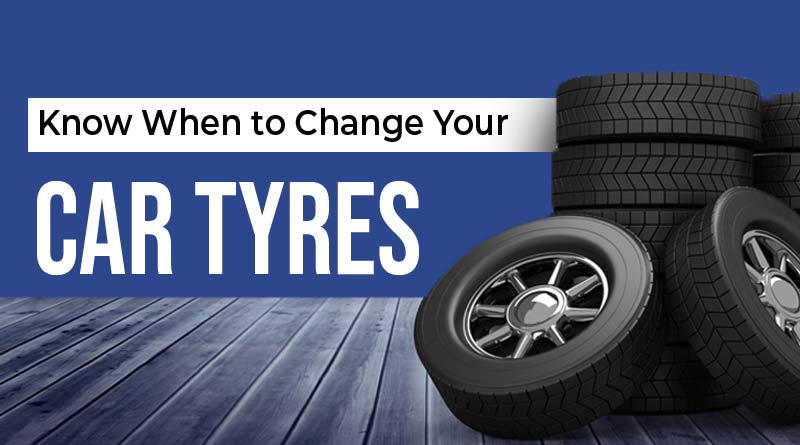A Comprehensive Guide: When to Change Your Car Tyres
Your car’s tires play a vital role in ensuring your safety and the overall performance of your vehicle. As you drive, the tires gradually wear out due to friction, road conditions, and other factors. Knowing when to change your car tires is essential to maintain optimal grip, handling, and traction on the road. In this comprehensive guide, we will explore the key indicators that suggest it’s time to replace your tires. From tread depth measurements to signs of wear and tear, we will provide you with valuable insights to help you make informed decisions about your car’s tires. Stay tuned for expert advice and tips on when and how to change your car tires effectively.
Why should you change your car’s tyre?

Changing your car’s tires is essential for several reasons. Here are some informative reasons why you should consider changing your car’s tires:
- Tread Wear: Over time, the tread on your tires wears down due to regular use. Tires with insufficient tread depth compromise your vehicle’s ability to grip the road properly, especially in wet or icy conditions. Changing worn-out tires ensures optimal traction and reduces the risk of accidents.
- Safety: Tires are a critical component of your vehicle’s safety system. They provide the necessary contact between your car and the road surface, affecting braking, handling, and overall stability. Worn or damaged tires can lead to longer braking distances, reduced control, and an increased chance of hydroplaning. Regularly changing your tires helps maintain your safety on the road.
- Punctures or Damage: Tires can experience punctures, cuts, bulges, or sidewall damage due to road hazards or accidents. A damaged tire can compromise its structural integrity and cause sudden blowouts or loss of control while driving. If you notice any signs of tire damage, it’s crucial to replace them promptly to avoid potential accidents or further tire failure.
- Age: Tires deteriorate with time, even if they have sufficient tread depth. Rubber compounds gradually degrade, leading to reduced performance and safety. As a general guideline, it is recommended to replace tires that are more than six years old, regardless of their visual condition or tread depth.
- Seasonal Changes: Depending on the climate and weather conditions in your area, it may be necessary to change to seasonal tires. Winter tires, for example, are designed with a different tread pattern and rubber compound to provide better traction in snowy and icy conditions. Switching to appropriate seasonal tires enhances your vehicle’s performance and safety during specific weather conditions.
- Fuel Efficiency: Worn-out or improperly inflated tires can increase fuel consumption. When the tires have low tread depth or are underinflated, the engine needs to work harder to propel the vehicle forward, resulting in higher fuel consumption. By regularly changing your tires and maintaining proper inflation, you can improve fuel efficiency and save money at the pump.
- Ride Comfort: Old and worn tires can contribute to a rough and uncomfortable ride. As tires age, they lose their ability to absorb road imperfections, leading to increased vibrations and noise in the cabin. Changing your tires when needed ensures a smoother and more comfortable driving experience.
When should you change your car tyre?
Knowing when to change your car’s tires is crucial for safety and performance. Here are some factors to consider:
- Tire Wear: Tires wear down over time, affecting their grip on the road. You can check tread depth using the coin test. If the tread is level with the wear bars, it’s time to replace them.
- Age: Tires can become unsafe due to aging, even if they have enough tread. Rubber degrades over time, making tires more prone to cracks and blowouts. It’s generally recommended to replace tires every six years.
- Driving Conditions: Rough roads or extreme weather can accelerate tire wear. If you frequently encounter such conditions, it’s wise to replace tires sooner to ensure safety.
Understanding Tyre Tread Depth

Understanding different types of tire tread depths is important for making informed decisions about when to replace your tires for optimal safety and performance on roads. Here are the key types to know:
- New tire tread depth: Brand-new tires typically have around 8-9mm of tread depth, but this can vary based on the tire’s make and model.
- Legal minimum tread depth: The minimum legal tread depth for car tires is 1.6mm across the central three-quarters of the tread. Tread depths below this are considered unsafe and not compliant with the law.
- Recommended tread depth: While the legal minimum is 1.6mm, it is generally recommended to replace tires when the tread depth reaches 2mm. This ensures better safety and performance on the road.
- Winter tire tread depth: Winter tires have deeper tread patterns compared to regular tires to improve traction on snow and ice. The minimum legal tread depth for winter tires is 3mm.
- Run-flat tire tread depth: Run-flat tires have reinforced sidewalls that allow limited driving on a flat tire. However, if the tread depth falls below 3mm, the tire may not be able to support the vehicle’s weight when flat.
Signs of Wear
Tires are important for grip and stability on the road, but they wear out over time. To ensure safety, it’s important to look for signs of wear and tear in your tires. Here are some signs to watch for:
- Tread Depth: Check that the tread depth is at least 1.6mm for proper grip. You can use a gauge, a one rupee coin, or look for tread wear indicator bars on the tire.
- Cracks: Look for cracks on the tire’s sidewall and tread area. These can be caused by extreme weather, over-inflation, or age-related wear.
- Bulges and Blisters: Check for bulges or blisters on the tire’s sidewall. These can indicate structural damage, often caused by hitting potholes or impact.
- Uneven Wear: Uneven tire wear can result from misaligned wheels or incorrect tire pressure. It’s important to correct this to maintain tire performance.
- Vibration: Excessive vibration while driving can signal worn-out or damaged tires. Get this checked to prevent potential problems.
Tyre Age
The age of a tire is important for its performance and safety on the road. Here are the different ages of a tire that you should know:
- Production Date: Each tire has a production date stamped on its sidewall, indicating the week and year it was manufactured. When buying a new tire, check this date to ensure it’s not too old.
- Service Life: Tires have a maximum service life of six years. After this time, even if they appear fine, they should be replaced. The rubber compound in tires degrades over time, affecting grip and stability.
- Tread Life: Tread life refers to the time it takes for the tread to wear down to the legal limit of 1.6mm. This can vary based on driving conditions, tire type, and maintenance.
- Storage Life: Tires can age and deteriorate even when not in use. It’s best to store them in a cool, dry, and dark place, away from direct sunlight and chemicals.
- Mileage Life: Mileage life refers to the number of miles a tire can cover before needing replacement. This varies depending on tire quality, type, and driving conditions.
Driving Conditions

Choosing the right type of tire for your car is important for a safe and comfortable driving experience. Consider the following driving conditions and suitable tire types:
- Dry conditions: In dry conditions, tires with harder compounds are preferred. They offer good grip and handling on dry roads.
- Wet conditions: Wet roads reduce tire grip, so tires with softer compounds are better for improved traction in such conditions.
- Snowy conditions: In areas with snow, winter tires with deeper grooves and softer compounds provide better grip. All-season tires can be used instead.
- Off-road conditions: For off-road driving, tires with deeper treads, like all-terrain or mud-terrain tires, offer better traction on rough terrains.
- High-speed driving: Performance tires are ideal for high-speed driving as they offer better grip and handling. Ensure tires are properly inflated and balanced for safety.
Choosing the Right tyres
When choosing the right set of tires for your vehicle, there are several key considerations to keep in mind. Here are 10 important factors to consider:
- Size: Ensure that you select tires that are the appropriate size for your vehicle. Refer to your vehicle’s owner manual or consult a tire professional to determine the correct tire size.
- Type of Vehicle: Consider the type of vehicle you have, whether it’s a car, SUV, truck, or motorcycle. Different vehicles have different tire requirements and load capacities.
- Driving Conditions: Assess the typical driving conditions you encounter. Consider whether you drive mostly on highways, city streets, off-road, or in areas with extreme weather conditions.
- Seasonal Performance: Determine if you need tires specifically designed for a particular season. All-season tires are versatile, while winter tires provide superior traction on snow and ice.
- Tread Pattern: Different tread patterns offer varying levels of traction and performance. Choose a tread pattern suitable for your driving needs, such as highway, off-road, or performance-oriented.
- Tread Life: Check the expected tread life of the tires you’re considering. Tires with longer tread life can be more cost-effective in the long run.
- Fuel Efficiency: Consider the tire’s rolling resistance, as it can impact fuel efficiency. Tires with lower rolling resistance can help improve fuel economy.
- Ride Comfort and Noise: Look for tires that offer a comfortable and quiet ride. Tires with good noise-reducing technology can enhance your driving experience.
- Brand and Quality: Choose reputable tire brands known for their quality and reliability. Consider reading reviews and seeking recommendations from trusted sources.
- Budget: Determine your budget for tires, keeping in mind that investing in high-quality tires can provide better performance, safety, and longevity.
Don’t compromise on safety—replace your tyres promptly when needed. A well-maintained set of tyres will provide optimal grip, handling, and peace of mind on the road. Stay proactive, stay safe, and enjoy your journey with tyres that are in top shape. Like this post? Don’t forget to check out our other short stories in our Quick Reads section.





This is really interesting, You’re a very skilled blogger. I’ve joined your feed and look forward to seeking more of your magnificent post. Also, I’ve shared your site in my social networks!
Hi there to all, for the reason that I am genuinely keen of reading this website’s post to be updated on a regular basis. It carries pleasant stuff.